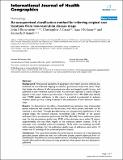| dc.contributor.author | Brownstein, John Samuel | |
| dc.contributor.author | Cassa, Christopher Anthony | |
| dc.contributor.author | Kohane, Isaac Samuel | |
| dc.contributor.author | Mandl, Kenneth David | |
| dc.date.accessioned | 2013-01-29T16:38:25Z | |
| dc.date.issued | 2006 | |
| dc.identifier.citation | Brownstein, John S., Christopher A. Cassa, Isaac S. Kohane, and Kenneth D. Mandl. 2006. An unsupervised classification method for inferring original case locations from low-resolution disease maps. International Journal of Health Geographics 5:56. | en_US |
| dc.identifier.issn | 1476-072X | en_US |
| dc.identifier.uri | http://nrs.harvard.edu/urn-3:HUL.InstRepos:10236035 | |
| dc.description.abstract | Background: Widespread availability of geographic information systems software has facilitated the use of disease mapping in academia, government and private sector. Maps that display the address of affected patients are often exchanged in public forums, and published in peer-reviewed journal articles. As previously reported, a search of figure legends in five major medical journals found 19 articles from 1994–2004 that identify over 19,000 patient addresses. In this report, a method is presented to evaluate whether patient privacy is being breached in the publication of low-resolution disease maps. Results: To demonstrate the effect, a hypothetical low-resolution map of geocoded patient addresses was created and the accuracy with which patient addresses can be resolved is described. Through georeferencing and unsupervised classification of the original image, the method precisely re-identified 26% (144/550) of the patient addresses from a presentation quality map and 79% (432/550) from a publication quality map. For the presentation quality map, 99.8% of the addresses were within 70 meters (approximately one city block length) of the predicted patient location, 51.6% of addresses were identified within five buildings, 70.7% within ten buildings and 93% within twenty buildings. For the publication quality map, all addresses were within 14 meters and 11 buildings of the predicted patient location. Conclusion: This study demonstrates that lowering the resolution of a map displaying geocoded patient addresses does not sufficiently protect patient addresses from re-identification. Guidelines to protect patient privacy, including those of medical journals, should reflect policies that ensure privacy protection when spatial data are displayed or published. | en_US |
| dc.language.iso | en_US | en_US |
| dc.publisher | BioMed Central | en_US |
| dc.relation.isversionof | doi://10.1186/1476-072X-5-56 | en_US |
| dc.relation.hasversion | http://www.ncbi.nlm.nih.gov/pmc/articles/PMC1702538/pdf/ | en_US |
| dash.license | LAA | |
| dc.title | An Unsupervised Classification Method for Inferring Original Case Locations from Low-Resolution Disease Maps | en_US |
| dc.type | Journal Article | en_US |
| dc.description.version | Version of Record | en_US |
| dc.relation.journal | International Journal of Health Geographics | en_US |
| dash.depositing.author | Brownstein, John Samuel | |
| dc.date.available | 2013-01-29T16:38:25Z | |
| dash.affiliation.other | HMS^Pediatrics-Children's Hospital | en_US |
| dash.affiliation.other | HMS^Pediatrics-Children's Hospital | en_US |
| dash.affiliation.other | HMS^Countway Library of Medicine | en_US |
| dash.affiliation.other | HMS^Medicine-Brigham and Women's Hospital | en_US |
| dash.affiliation.other | HMS^Pediatrics-Children's Hospital | en_US |
| dash.affiliation.other | HMS^Health Sciences and Technology | en_US |
| dash.affiliation.other | HMS^Pediatrics-Children's Hospital | en_US |
| dc.identifier.doi | 10.1186/1476-072X-5-56 | * |
| dash.contributor.affiliated | Brownstein, John | |
| dash.contributor.affiliated | Kohane, Isaac | |
| dash.contributor.affiliated | Cassa, Christopher | |
| dash.contributor.affiliated | Mandl, Kenneth | |


